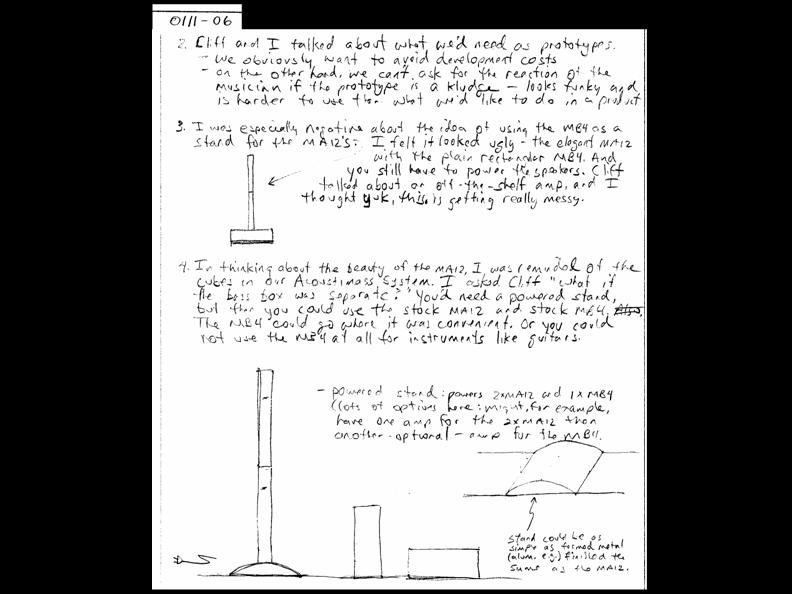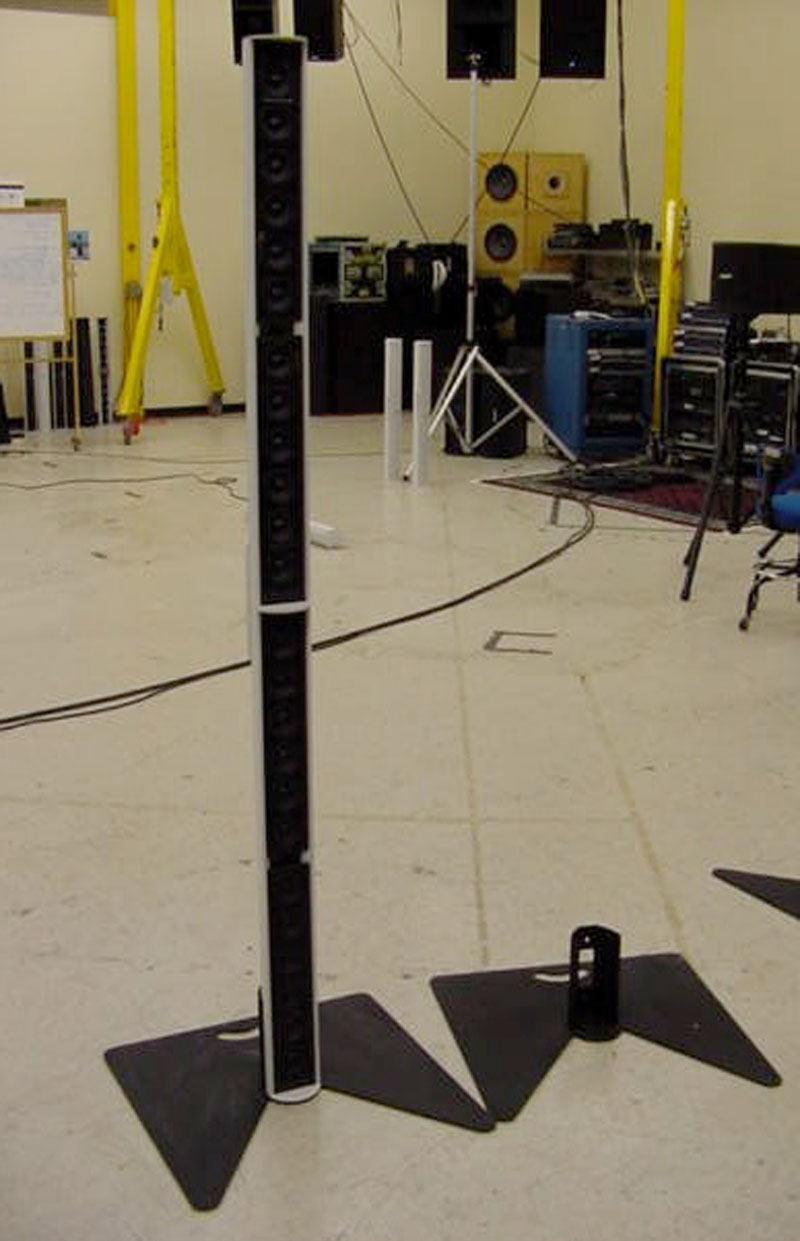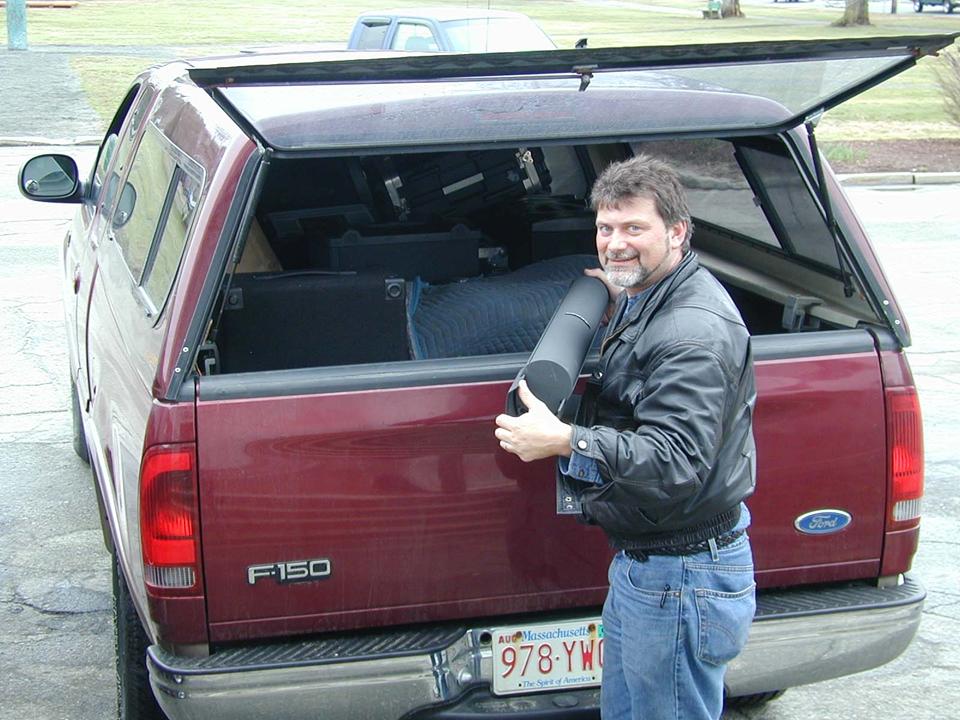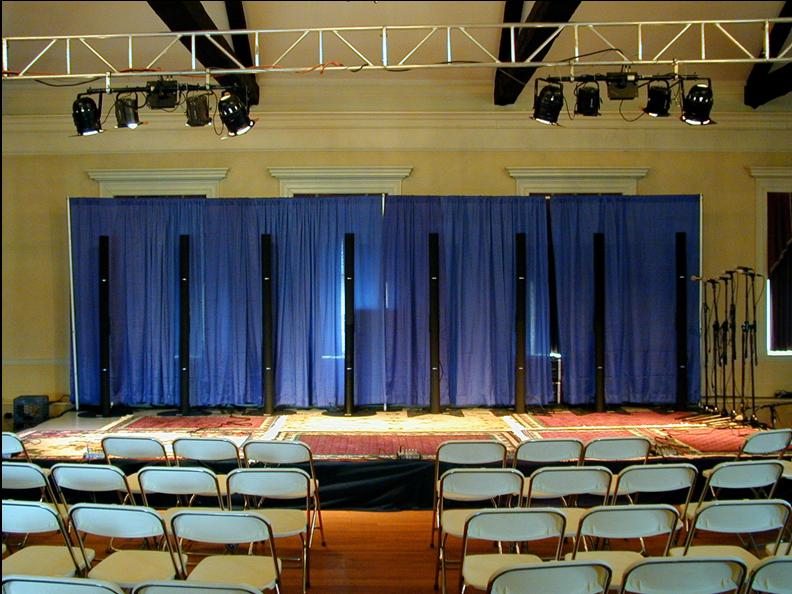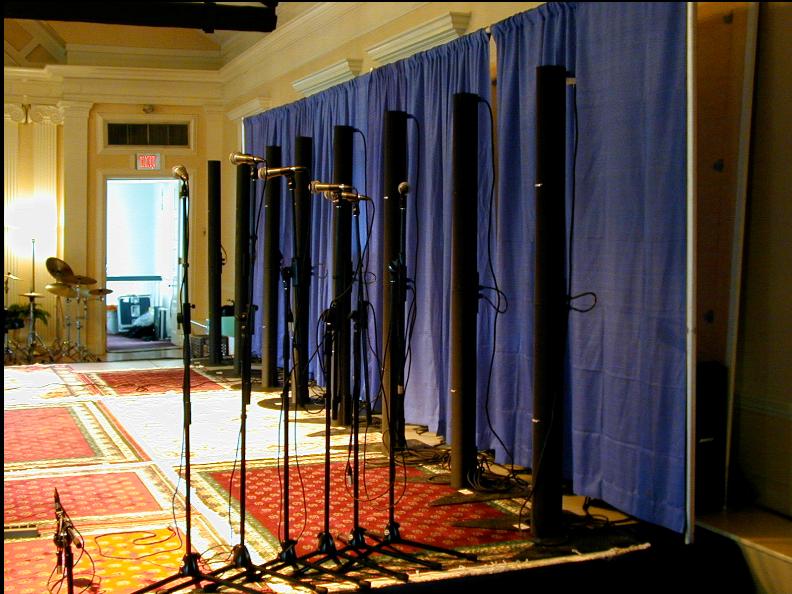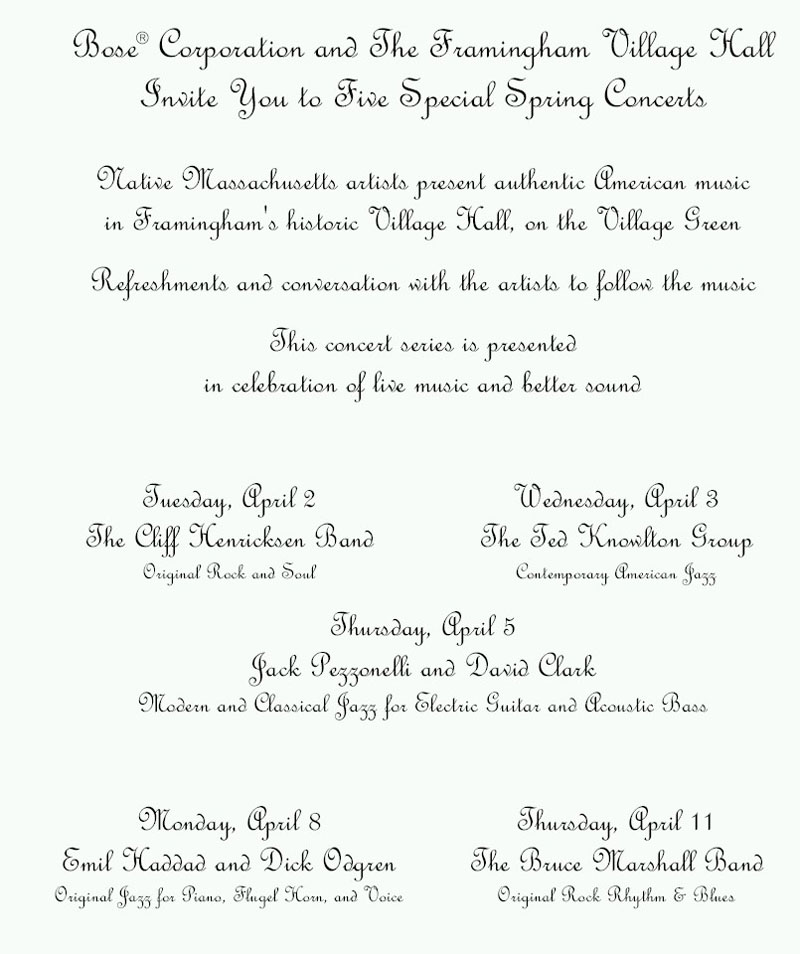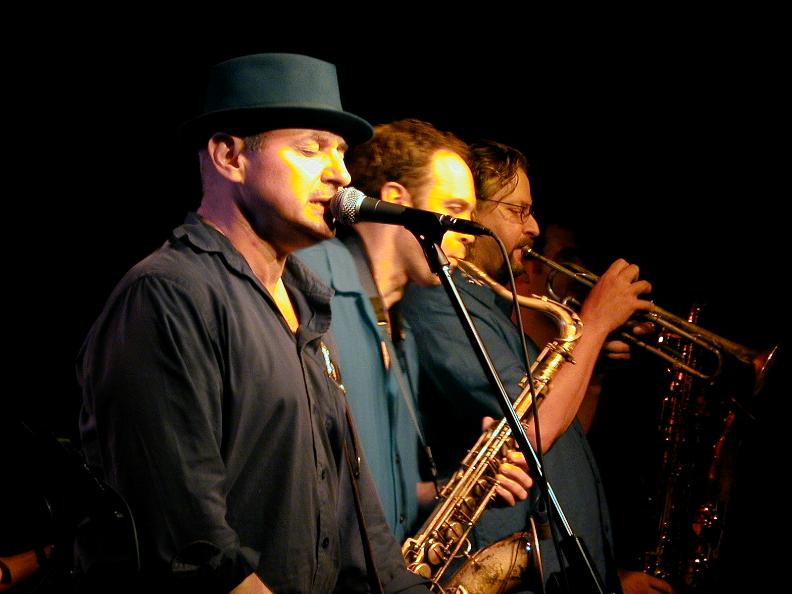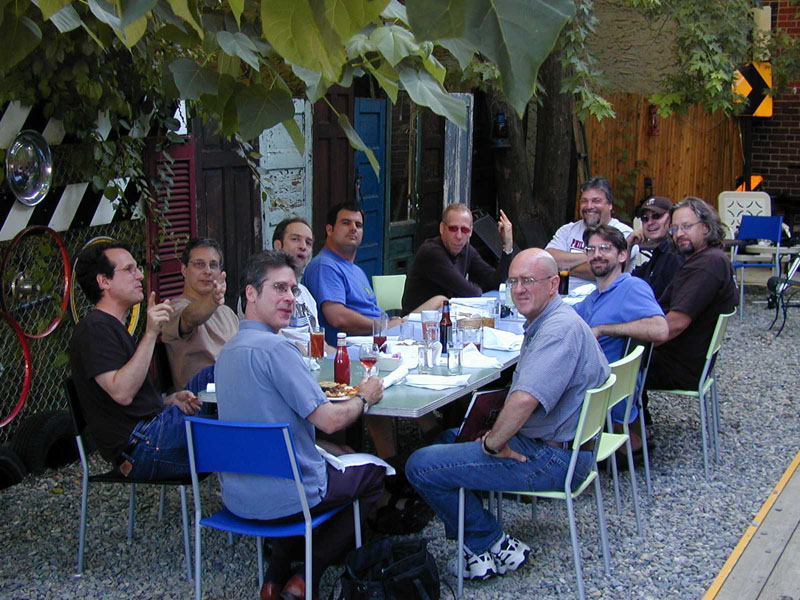Testing Our 2nd Generation Prototype
Contents
Building the 2nd Generation Prototypes
Cliff and Joe had built a number of prototypes of what was to become the L1 speaker. See the article First Research Prototype for more details.
In late 2001 and early 2002 Ken and Cliff decided to build another, more sophisticated prototype based on everything they had learned.
Cliff fabricated stands for what had already become the Bose MA12 line array for installed applications. The MA12 was a commercial offshoot of the early L1 prototype work: Commercial Offshoot of L1 Research Project.
Cliff and some of the lab technicians built small racks that housed LabGruppen power amps and a DSP controller where we could dial in EQ and limiting for the 2nd generation prototypes.
We used Bose MB4 bass boxes.
As you can see from the following notebook entry, this is where Bose decided to go with a separate bass box -- a momentous decision.
Here's a photo of the 2nd generation prototype. For the first time, Ken felt they had something that was really starting to look elegant and truly unique -- as unique as the invention.
Testing the Prototypes on Real Concerts
Cliff built about eight of these 2nd generation prototypes and made them so they could be easily transported.
This is a shot of one of our speaker engineers, Pete (also an excellent drummer) who had loaded up his pickup truck with ALL of the prototype systems. Ken remembers going to get his camera and saying "Pete! Wait!" And taking this picture. It really hit home that here was a new kind of amplification system -- one that replaced conventional PA, monitors, backline amps, mixers, and most of the wires with seven-foot-tall, coffee-mug-wide, portable line arrays. It hit the small group hard at this time.
Many, many live concert tests were conducted with this set of 2nd generation prototypes.
These concert-tests were roughly broken into two categories:
1. Same venue, lots of different bands.
2. Same band, lots of different venues.
Concerts in One Venue With Different Bands
For the first category, a series of concerts took place in the Spring of 2002.
Although it was not known at the time, the team was only 18 months from launching a commercial product in October of 2003.
The historic Village Hall in Framingham was chosen for this batch of concerts.
It's a challenging room, fitting a few hundred when full. It's very reverberant. It was chosen for several reasons.
- It was close, only about 5 minutes from the lab.
- It was typical of the places people play.
- It was acoustically challenging: if the prototypes were successful in Village Hall they'd be successful in the better behaved halls.
- The testing could be kept relatively quiet.
Cliff and Ken set up what they called their "soldiers of sound" on a rented stage, as shown below.The MB4 bass boxes behind the curtain. If you look hard you can also see the "baby mixers" that were part of the prototype systems. These were four channel mixers.
At this time, it was just Cliff and Ken and the occasional hired crew. Ken and Cliff rented trucks, pipe and drape, carried all the gear, made all the arrangements and communications (like the above) and assembled and repaired stuff in Cliff's garage, about a half mile from Village Hall. Ken insisted on this arrangement as the only way to experience what eventual customers might experience and thus know "in their bones" as he put it what design decisions to make when it came time (hopefully) to commercialize the idea.
Here's another shot of the stage. The team wanted to show the fact that for the first time in a long time the stage was super neat. You could really see the musicians and they could really see their audiences.
Here's a copy of the advertisement that was placed in the local newspaper to attract audiences without attracting attention to the new technology. This was really tricky to pull off. On the one hand, the team was intent of doing a set of real world tests -- to be absolutely certain that their beliefs and claims could be realized. They wanted not just to prove that musicians liked the sound, but that audiences did too. They wanted to prove that the L1 concept meant better live music. And so we had to have real concerts. On the other hand, they wanted desperately to keep their work quiet. It would be terrible for news to leak out of our work.
In the advertisement there was no mention of new technology being used. Just a celebration of live music and better sound.
Ken and Cliff received excellent reactions from the musicians. The ones that especially loved it and took to it the best were the jazz players, who are more used to hearing each other and playing together. Least adaptable were rock musicians who are used to playing to monitors and not necessary playing with the whole band.
The prototype systems performed reliably and excited much less reverberation by not sending sound to the hall’s upper reaches. It made instruments responsive and musicians said it was easy to engage their audiences. Cliff said of the experience, "The sound wrapped around me, like a hug from someone who loves me, and then went out to the audience to do the same. I can still remember how it felt and how it sounded. It’s a really beautiful memory for me."
Concerts in Different Venues With One Band
After the Village Hall tests, Cliff and Ken began the process of testing the 2nd generation prototypes in different venues. They decided to take a road trip to Philadelphia where Cliff knew a bunch of professional musicians from when he lived in this area. Cliff had played in the Philly/So Jersey clubs and music halls mostly with a band called the “Allstars” and most of them were still there, active as musicians. Cliff and Ken rented and drove a white van with the prototype systems from Framingham to Philly.
They invited an extraordinary singer and guitarist Tony Sarnoto join them, after the Guitar Summit (see Reinventing the Electric Guitar As We Know It for details) to play at a great club recommended by bassist Rick Prince called “North By Northwest”. Local musicians and music-business people (booking agents, studio and record people, promoters, etc) were invited. Ken did an early version of the presentation that was to become Music is Human to explain what we would be doing onstage. Then the band played. It was a great lineup, including Allstars Rick Prince (bass), Rick Valenti (harp and vocals), Jay Davidson (sax, later to play with Cinderella, the “Standing In the Shadows of Motown” tour and with Steve Winwood), Fred “The Red” Berman on drums (now touring with Amos Lee), Doug DeHays (bari) and Steve Jankowski (trumpet). Cliff played keys. Ken and Cliff both felt it was a highly successful event: musicians and audience alike were thrilled with the experience. There was quite a buzz.
After the event, back at the hotel, Ken invited Tony Sarno to join the team as someone who could representative professional musicians and electric and acoustic guitar players. His growing ability to play genuine electric guitar through the L1 (and endless stream of different ways of getting guitar tone) and front the soon-to-be-called Bose demonstration band THE Linemen would be his work at Bose. He would be a musician-to-musician spokesman for the L1 and for the company, especially as he could provide advice and authentic opinions about a real recording artist's experience with the system. Tony accepted and did this work for two years, leaving the corporate world to get back to being a full time musician again.
In the photo, that's Tony singing, Jay saxing and Steve trumpeting.
Here's the musicians having dinner in the side courtyard at NXNW before the show. Starting far left at the table and working around clockwise: Ken (pointing up), Rick Prince (pointing at the camera), Jay Davidson, Doug DeHays (I think), Fred the Red (testing wind direction), Rick Valenti, Tony, Steve Jankowski, not sure, me and Tim Jordan, a local guitarist, singer and songwriter. Rick P and Tim are in a band together as of this writing.
Soon after the Philly test, Tony relocated to the Framingham area from Nashville, and he and Cliff started recruiting local players for an in-house test band. They first met with bassist Wolf Ginandes, who Cliff knew and had played some with. Wolf in turn brought in Marty Richards (J. Geils, Peter Wolf, Gary Burton, others) as drummer. Tony knew local saxman Bruce "the Goose" McGrath from previous bands they were in together, and Goose brought trumpet great "Doc" Channonhouse. Last, Cliff "Goodsy" Goodwin came along on the advice of Pete and Wolf as second guitarist. His work as music director for the Joe Cocker Band made him the perfect candidate for MD for this band, and Wolf came up with the name THE Linemen.
[need to add images and text for The Linemen in different venues here]
